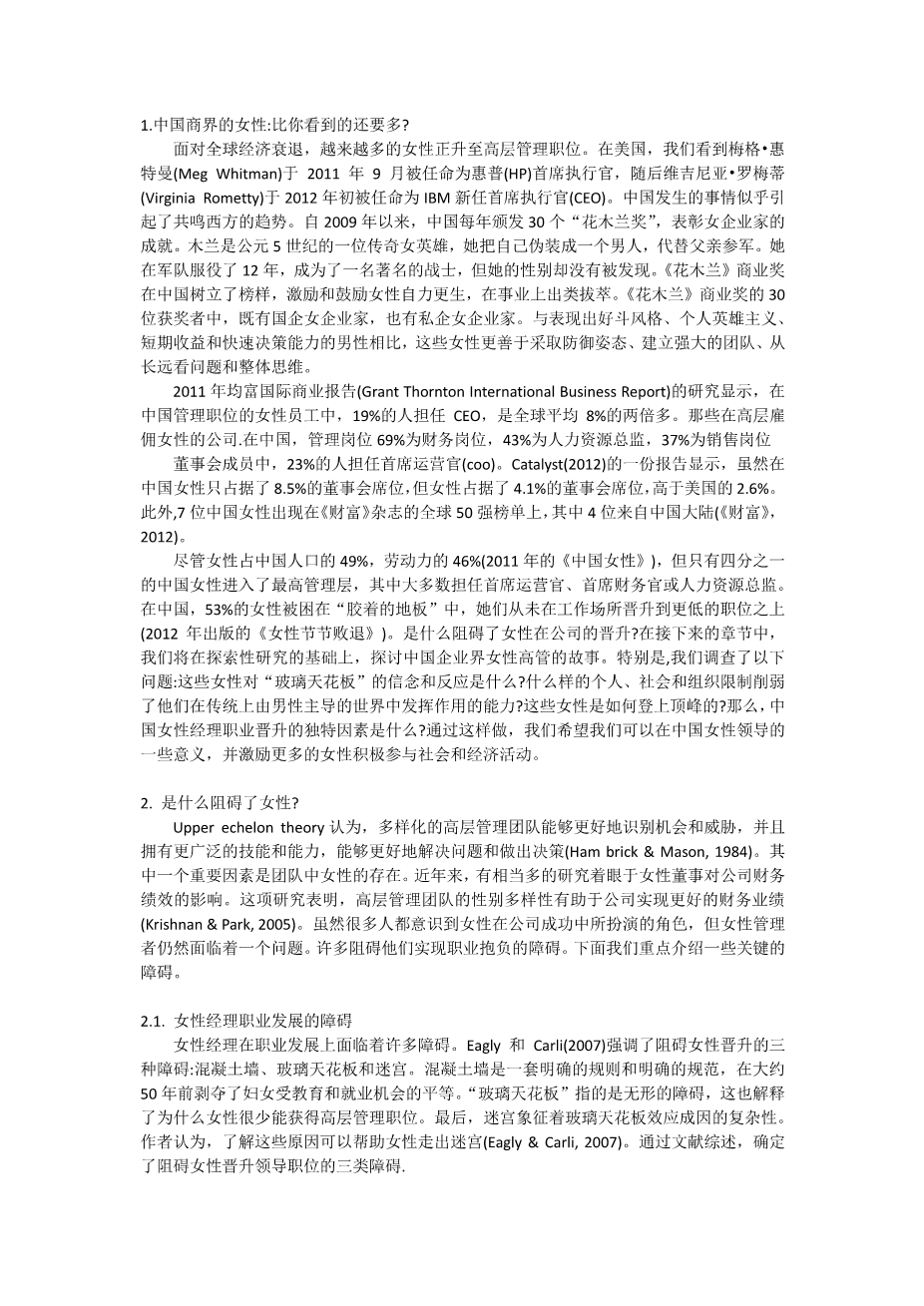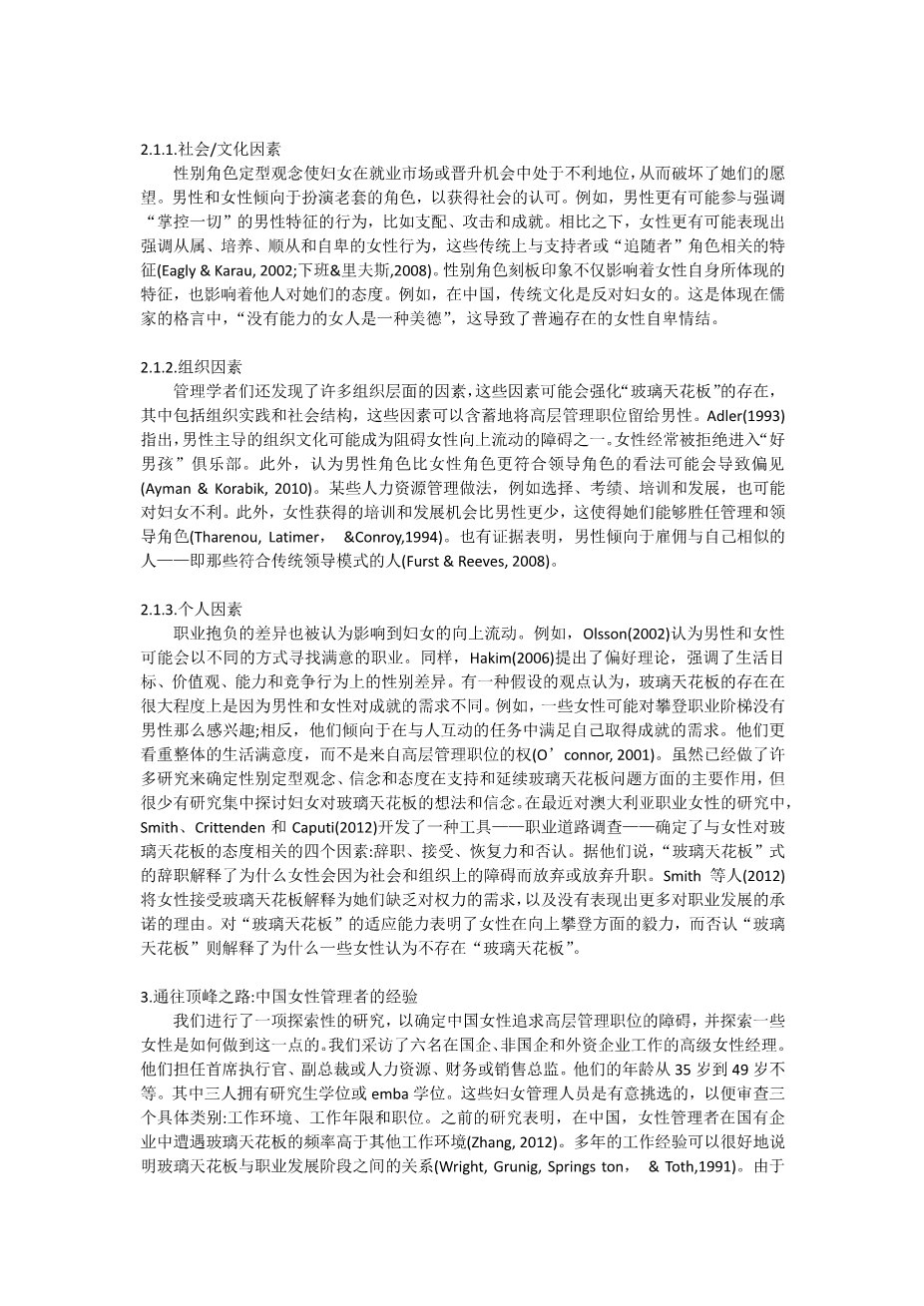1.Women in China’s corporate world: More than meets the eye?
In the face of global economic downturns, an increasing number of women are rising to top management positions. In the United States, we saw the appointment of Meg Whitman to lead HP in September 2011 followed by Virginia Rometty’s appointment as IBM’snew chief executive officer (CEO) in the beginning of 2012. What happened in China seems to resonate with the trend in the West. Since 2009, China has been recognizing women entrepreneurs’ achievements by presenting 30 ‘Mulan in Business’ awards each year. Mulan is a legendary heroine from the 5th century who disguised herself as a man to take her father’s place in the army. She served in the army for 12 years and became a celebrated warrior without her gender being discovered. The Mulan in Business awards have provided role models in China to inspire and encourage women to be self-reliant and to excel in their careers. Included in the list of 30 Mulan in Business award winners are women entrepreneurs from both state-owned enterprises (SOEs) and private companies. Compared with their male counter-parts who demonstrate an aggressive style, individual heroism, short-term gains, and quick decision making, these women are better at taking a defensive position, building strong teams, taking long-term perspectives, and thinking holistically.
Research from the 2011 Grant Thornton International Business Report reveals that among China’s female workforce in managerial positions, 19% hold the title of CEO, more than double the global average of 8%. Of the companies that employ women in top managerial positions in China, 69% are employed in financial positions, 43% are employed as human resources directors (HRDs), 37% are employed as sales directors, and 23% are employed as chief operating officers (Coos). A Catalyst (2012) report shows that although women only hold 8.5% of board seats in China, 4.1%of board chairs are held by women, higher than the 2.6% in the United States. In addition, seven Chinese women appeared on Fortune’s International Power 50 List, four of whom come from mainland China (Fortune, 2012).These figures reflect a growing number of women who aspire to play key roles in China’s economic success.
Although women make up 49% of China’s population and 46% of its labor force (‘‘Women in China,’’2011), only one of four Chinese women has made it to the top management level, with a majority of those taking the position of COO, CFO, or HRD. In China, 53% of women are caught in sticky-floor situations and never advance beyond lower-level positions in the workplace (‘‘Women Losing Ground,’’ 2012). What keeps women from climbing the corporate ladder? In the following sections, we explore the stories of women executives in China’s corporate world based on an exploratory study. In particular, we investigated the following questions: What are these women’s beliefs about and responses to the glass ceiling? What personal, social, and organizational constraints undermine their capacity to play a part in a traditionally male-dominant world? How did these women make their way to the top? And, what factors are unique to Chinese women managers’ career advancement? By so doing, we hope we can make some sense of female leadership in China and inspire more women to actively participate in social and economic activities.
2. What holds women back?
Upper echelon theory argues that a diverse top management team is better equipped to identify opportunities and threats, and possesses a broader set of skills and capabilities for better problem solving and decision making (Ham brick amp; Mason, 1984). One important factor contributing to this is the presence of women on the team. In recent years, there has been considerable research looking at the impact of female representation on boards of directors on firms’ financial performance. This body of work reveals that gender diversity in top management teams has helped companies achieve better financial performance (Krishnan amp; Park, 2005). Although many individuals are aware of the role women play in companies’ success, women managers still face a
number of barriers holding them back from reaching their career aspirations. We highlight some of the key barriers below.
2.1. Barriers to women managers’ career advancement
Women managers are faced with a number of barriers to their career advancement. Eagly and Carli (2007) highlight three types of obstacles preventing women from moving up the career ladder: the concrete wall, the glass ceiling, and the labyrinth. The concrete wall is a set of explicit rules and clear-cut norms that deprived women of equal education and job opportunities some 50 years ago. The glass ceiling refers to invisible barriers and explains why women have little access to top management positions. Finally, the labyrinth symbolizes the complexity of the causes of the glass-ceiling effect. According to the authors, understanding these causes can help women negotiate the labyrinth (Eagly amp; Carli, 2007). Through literature review, three types of barriers to women’s rise in leadership positions were identified (Table 1).
2.1.1. Social/Cultural factors
Gender-role stereotypes undermine the aspirations of women by putting them at a disadvantage in the job market or in opportunities for promotion. Men and women tend to adopt stereotypical roles to be socially accepted. For example, men are more likely to engage in behaviors that emphasize the masculine aspect of ‘being in charge,’ such as dominance, aggression, and achievement. In contrast, women are more likely to display feminine behaviors that emphasize affiliation, nurturing, deference, and abasement, traits traditionally associated with supporter or ‘follower’ roles(Eagly amp; Karau, 2002; Furst amp; Reeves, 2008). Gender role stereotypes not only influence the characteristics embodied by women themselves but al
全文共27780字,剩余内容已隐藏,支付完成后下载完整资料


英语译文共 6 页,剩余内容已隐藏,支付完成后下载完整资料
资料编号:[453080],资料为PDF文档或Word文档,PDF文档可免费转换为Word
以上是毕业论文外文翻译,课题毕业论文、任务书、文献综述、开题报告、程序设计、图纸设计等资料可联系客服协助查找。


